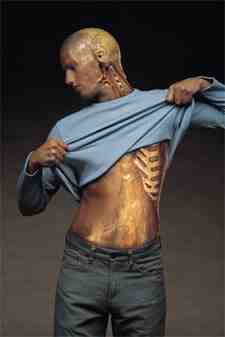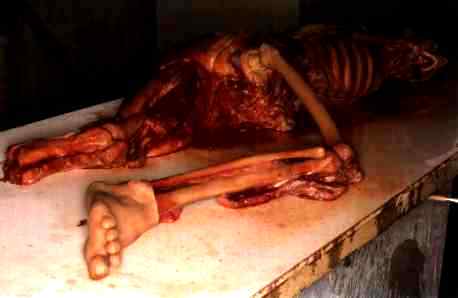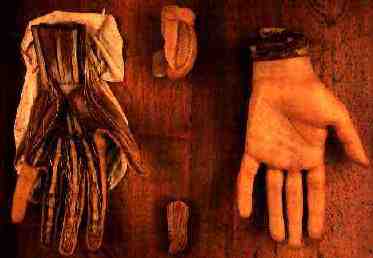Bodies of Evidence

The Hayward Gallery
19 October 2000 – 14 January 2001
Art and science are usually regarded as being separate, and often contradictory disciplines, emotion and logic in opposition without much apparent common ground. But such ground certainly exists, and the Spectacular Bodies exhibition covers some of it, with particular regard to human anatomy.
The element of it which has received most publicity are the wax models used to teach anatomy, back in the days before every medical student got their own corpse to cut up. Then, the only available bodies were those of condemned criminals, making dissections a rarity, and something of a theatrical event as a result. In lieu of real flesh, elaborately detailed facsimiles were constructed out of coloured wax and other materials, and these form the centerpiece here.
Looking at them, a whole range of emotions ran across my mind. They seemed unerringly lifelike, the wax glistening moistly, but there is also something deeply disturbing about seeing human bodies cut up and displayed like slabs of meat in a butcher’s shop. Others seemed like alien flowers, petals opening to reveal strange organs of unknown purpose – for how many of us know what a pancreas looks like, anyway? Yet the more moderately discreet were barely distinguishable from regular statues. Take someone’s skin off, pose them appropriately, and they don’t look all that much different from a body-builder or well-toned athlete, though it was clear where Clive Barker got many of his ideas for Hellraiser!

Even now, the form is carried on, albeit less for instructional purposes, and merely for the artistic content. Shown on the right, is John Isaacs’ A Necessary Change of Heart, which sat in the corner of the gallery, as if its subject had fallen from some great celestial slaughterhouse. While almost all the rest of the exhibits were behind glass, this one was out in the open (albeit with a museum guard hovering nearby), adding to its queasy appeal. If Isaacs ever wants a career in the movie industry, I’m sure he has a great future ahead of him, making highly-convincing special effects.
Less interesting were the more regular works of art, although they did show how many artists have taken a specific interest in anatomy: Stubbs (when he wasn’t drawing horses), Rembrandt, Durer, Turner and Da Vinci among them. Some of the last-named’s notebook pages were on display – borrowed from the Queen – and, as an aside, it was interesting to see them written in “reverse”, from right to left. There were also some “installations” from modern artists, which were without exception, crap: what exactly is a video of open-heart surgery playing above a neatly-made bed supposed to signify? I did have to laugh at the jar of bulls’ testicles which had a mouth projected onto it, if only for the look on people’s faces when they read the label, and realised exactly what they’d been staring at for the past few minutes.

Fortunately, the non-art exhibits had a fascinating range, from medieval textbooks which sought to explain how the four humours affected personality, through to a jar containing a pickled foetus, with beads on its wrist for no readily apparent reason – eat your heart out, Damien Hirst. Ironically, there were also masks cast from the faces of Burke and Hare, the notorious “resurrectionists” from Edinburgh, whose trade was in supplementing the officially-available corpses, with ones they ended up creating themselves. What goes around, comes around, and they now find themselves the objects of public attention.
Another important area covered by the exhibition, was the way scientists have attempted to link mood and character to physical attributes. The ‘science’ of reading faces, physiognomics, has been around at least since the time of Da Vinci, and was strongly supported by the likes of Francis Galton – who also was one of the discoverers of fingerprinting. Phrenology, the reading of the bumps on the head as an indicator of mental disturbance or criminal tendencies, lead to the gathering of enormous amounts of data, though it seems that their interpretation tended strongly to pander to the preconceptions and prejudices of the time.
There is a lot to see in this exhibition – perhaps too much – and by the end, I was feeling distinctly body-weary. There’s no doubt that we are all examples of remarkable natural engineering, but as with cars and computers, my interest in the internal workings is limited, when things are otherwise going well. However, the images of the anatomical models will stay with me for a long time, and the names of Pinson, Zumbo, Susini and Towne undeniably deserve a higher place in art history than they have received. Definitely, their wax works…